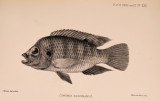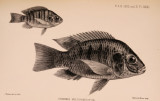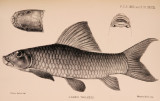| OCR Text |
Show 294 MR. C. TATE REGAN OX [Nov. 4, ethmoid, in opposition to the Tetrodontidae, with short or narrow ethmoid, not prominent. I find that in Tetrodon lagocephalus, scleratus, Icevigatus, &c. the ethmoid is long, by no means narrow, and at least as prominent as in any species of the so-called Canthigasteridae. The Chonerhinidse are also separated on account of the increased number of vertebrae and dorsal and anal rays, but as in the Tetrodontidae the vertebrae vary from 17 to 22 in number, and the dorsal rays from 6 to 19, it is scarcely logical to separate from them Chonerhinus, with 24 vertebrae and 25-26 dorsal rays, nor Xenopterus with 29 vertebrae and 32-38 dorsal rays, on that account alone. The question as to how many genera it is convenient or useful to recognize in this family is a very vexed one. Perhaps, on account of the many strange and abnormal features which unite the Tetrodontidae and distinguish them from more typical fishes, one is rather apt to overlook the differences which exist among them ; nevertheless, it is very evident that many of the so-called genera are incapable of definition and cannot be maintained. The genera Ephippion, Tropidichthys, Chonerhinus, and Xenopterus can be easily defined ; but I am inclined to unite the remaining species in a single genus Tetrodon, as the differences in the structure of the skull and of the nasal organ show so many gradations that they can hardly be used for generic diagnoses. In Tetrodon psittacus Bl. Schn. I find that the frontals extend to the orbital margins, therefore Colomesus Gill, if a valid genus, has not been correctly diagnosed. Genera. 1. T etrodon Linn.-Body oblong or elongate, broad or somewhat compressed, prickly or smooth. L). 6-19. A. 6-17. Vertebrae 17-22. Praefrontals, frontals, and post-frontals with lateral expansions which form the orbital roof. Nostrils either separate or confluent. 2. E ph ip p io n Bibr.-Differs in having the body armed with bony plates. Nostrils confluent. Skeleton unknown. 3. T r o p id ich th y s Bleeker.- Body compressed. D. 8-10. A. 8-10. 'Vertebra? 18. Nostrils confluent, a single small aperture on each side. Ethmoid long, narrowed forwards. Posterior part of frontals with paired lateral crests. 4. C h o n e r h in u s Bleeker.-Differs from Tetrodon in that the dorsal and anal fin-rays are in increased number, as are the vertebrae (D. 25-26. A. 23-25. Vertebrae 24). The praefrontals small, without lateral expansions. The nasal organs are very similar to those of T. pat oca, but developed into a large funnel-sliaped rim. 5 . X enopterus Hollard.-Differs from Chonerhinus in having more vertebrae and dorsal and anal rays (Vertebra? 29. D. 32-38. |
































































































































































































































































































































